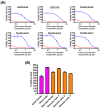Age Is Just a Number: Ontogenetic Conservation in Activation of Blood Clotting Factors VII, X, and XII by Caucasus Blunt-Nosed Viper (Macrovipera lebetina obtusa) Venoms
- PMID: 39728778
- PMCID: PMC11728708
- DOI: 10.3390/toxins16120520
Age Is Just a Number: Ontogenetic Conservation in Activation of Blood Clotting Factors VII, X, and XII by Caucasus Blunt-Nosed Viper (Macrovipera lebetina obtusa) Venoms
Abstract
This study examined the pathophysiological effects of venoms from neonate and adult specimens of the viperid snake Macrovipera lebetina obtusa, focusing on their ability to activate various blood clotting factors in human plasma. All venoms exhibited strong procoagulant properties. In concentration-response tests, the clotting potency of the neonate venoms fell within the range of their parents' maximum clotting velocities and areas under the curve. Intriguingly, females were more potent than males within each age group, but this requires a larger sample size to confirm. Antivenom neutralization efficacy was equipotent across age groups. The venoms potently activated Factor X (FX) robustly, consistent with previous knowledge of this genus. For the first time, the ability to activate Factors VII (FVII) and XII (FXII) was identified in this genus, with FXII exhibiting particularly strong activation. The study found no significant ontogenetic variation in procoagulant venom potency on human plasma, convergent with the Daboia genus, the other large-bodied lineage within the Palearctic viperid clade. However, the activation of FXII and FVII reveals previously undocumented pathways in the procoagulant activity of these venoms, contributing to the broader understanding of venom evolution and its clinical impacts. These findings have implications for venom biodiscovery and the development of antivenoms, highlighting the complexity of clotting factor activation beyond traditional investigations that have myopically focused upon FX and prothrombin pathways, thereby underscoring the importance of exploring additional clotting factors.
Keywords: Macrovipera; antivenom; evolution; ontogeny; venom.
Conflict of interest statement
R.S. is employed by antivenom producer Inosan Biopharma, which made the antivenom tested in this manuscript. However, the company did not have input in experimental design or reviewing of results before publication. The other authors declare no conflicts of interest.
Figures



Similar articles
-
The biology and toxinology of blunt-nosed vipers.NPJ Biodivers. 2025 Jun 3;4(1):21. doi: 10.1038/s44185-025-00090-w. NPJ Biodivers. 2025. PMID: 40461826 Free PMC article. Review.
-
Snake Venom Makeover: Age-Dependent Variations in Procoagulant Biochemistry of Egyptian Saw-Scaled Viper (Echis pyramidum pyramidum) Venom.Toxins (Basel). 2025 Mar 19;17(3):149. doi: 10.3390/toxins17030149. Toxins (Basel). 2025. PMID: 40137922 Free PMC article.
-
Clinical implications of differential procoagulant toxicity of the palearctic viperid genus Macrovipera, and the relative neutralization efficacy of antivenoms and enzyme inhibitors.Toxicol Lett. 2021 Apr 1;340:77-88. doi: 10.1016/j.toxlet.2020.12.019. Epub 2021 Jan 4. Toxicol Lett. 2021. PMID: 33412251
-
Tiny but Mighty: Vipera ammodytes meridionalis (Eastern Long-Nosed Viper) Ontogenetic Venom Variations in Procoagulant Potency and the Impact on Antivenom Efficacies.Toxins (Basel). 2024 Sep 14;16(9):396. doi: 10.3390/toxins16090396. Toxins (Basel). 2024. PMID: 39330854 Free PMC article.
-
Biochemistry and pharmacology of proteins and peptides purified from the venoms of the snakes Macrovipera lebetina subspecies.Toxicon. 2019 Feb;158:16-32. doi: 10.1016/j.toxicon.2018.11.294. Epub 2018 Nov 23. Toxicon. 2019. PMID: 30472110 Review.
Cited by
-
The biology and toxinology of blunt-nosed vipers.NPJ Biodivers. 2025 Jun 3;4(1):21. doi: 10.1038/s44185-025-00090-w. NPJ Biodivers. 2025. PMID: 40461826 Free PMC article. Review.
-
Snake Venom Makeover: Age-Dependent Variations in Procoagulant Biochemistry of Egyptian Saw-Scaled Viper (Echis pyramidum pyramidum) Venom.Toxins (Basel). 2025 Mar 19;17(3):149. doi: 10.3390/toxins17030149. Toxins (Basel). 2025. PMID: 40137922 Free PMC article.
References
-
- Kasturiratne A., Wickremasinghe A.R., de Silva N., Gunawardena N.K., Pathmeswaran A., Premaratna R., Savioli L., Lalloo D.G., de Silva H.J. The global burden of snakebite: A literature analysis and modelling based on regional estimates of envenoming and deaths. PLoS Med. 2008;5:e218. doi: 10.1371/journal.pmed.0050218. - DOI - PMC - PubMed
-
- World Health Organization Snakebite Envenoming. [(accessed on 20 September 2024)]. Available online: https://www.who.int/health-topics/snakebite.
Publication types
MeSH terms
Substances
Grants and funding
LinkOut - more resources
Full Text Sources

